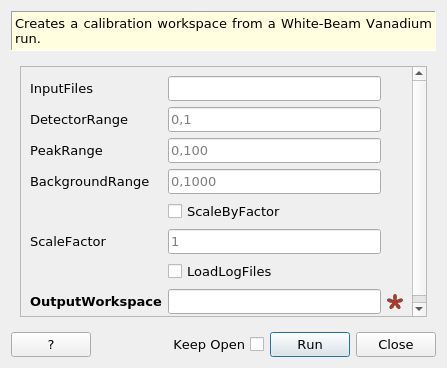\(\renewcommand\AA{\unicode{x212B}}\)
IndirectCalibration v1¶

IndirectCalibration dialog.¶
Summary¶
Creates a calibration workspace from a White-Beam Vanadium run.
Properties¶
Name |
Direction |
Type |
Default |
Description |
|---|---|---|---|---|
InputFiles |
Input |
str list |
Comma separated list of input files |
|
DetectorRange |
Input |
long list |
0,1 |
Range of detectors. |
PeakRange |
Input |
dbl list |
0,100 |
Time of flight range over the peak. |
BackgroundRange |
Input |
dbl list |
0,1000 |
Time of flight range over the background. |
ScaleByFactor |
Input |
boolean |
False |
Set to True to enable Scaling, if false output will be normalised to 1. |
ScaleFactor |
Input |
number |
1 |
Factor by which to scale the result. |
LoadLogFiles |
Input |
boolean |
False |
Option to load log files. |
OutputWorkspace |
Output |
Mandatory |
Output workspace for calibration data. |
Description¶
Creates a calibration workspace to be used with inelastic indirect reductions, allowing for the correction of relative detector intensities.
Either a single run file or range of runs in .raw format can be given to the algorithm which are then merged into a single run using MergeRuns, a flat background is then calculated and normalised to give the output workspace.
Note
This algorithm only supports files containing histogram data.
Workflow¶
Usage¶
Example - create calibration workspace for IRIS
Note
To run these usage examples please first download the usage data, and add these to your path. In Mantid this is done using Manage User Directories.
# Create a calibration workspace
cal_ws = IndirectCalibration(InputFiles='IRS26173.raw',
DetectorRange='3,53',
PeakRange='62500,65000',
BackgroundRange='59000,61500')
print('Calibration workspace has {:d} bin(s) and {:d} spectra.'.format(
cal_ws.blocksize(), cal_ws.getNumberHistograms()))
Output:
Calibration workspace has 1 bin(s) and 51 spectra.
Categories: AlgorithmIndex | Workflow\Inelastic | Inelastic\Calibration
Source¶
Python: IndirectCalibration.py
